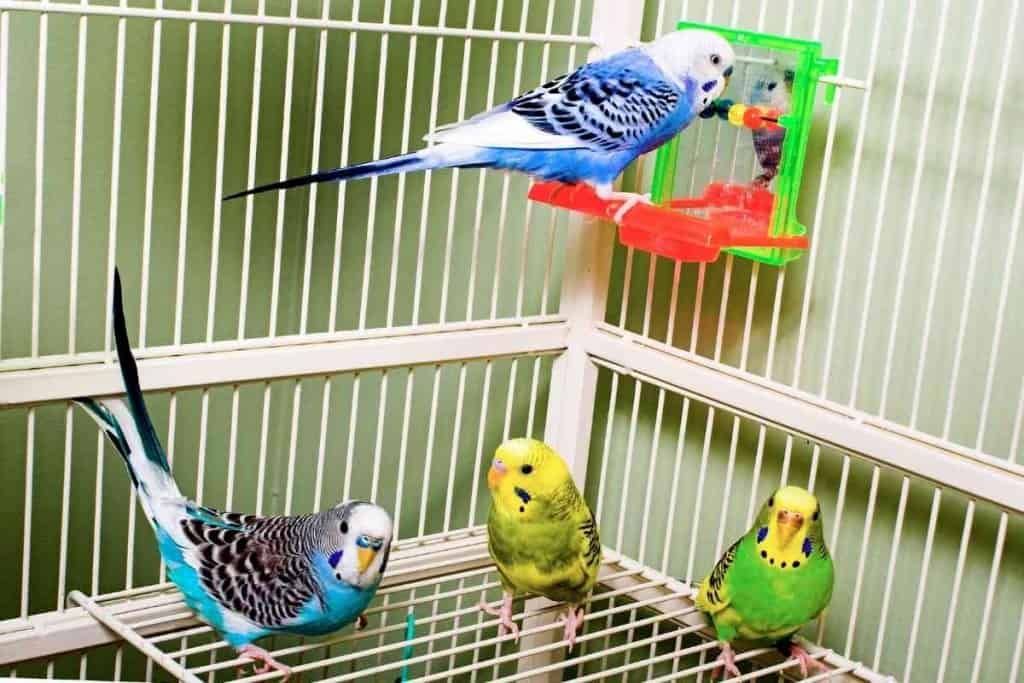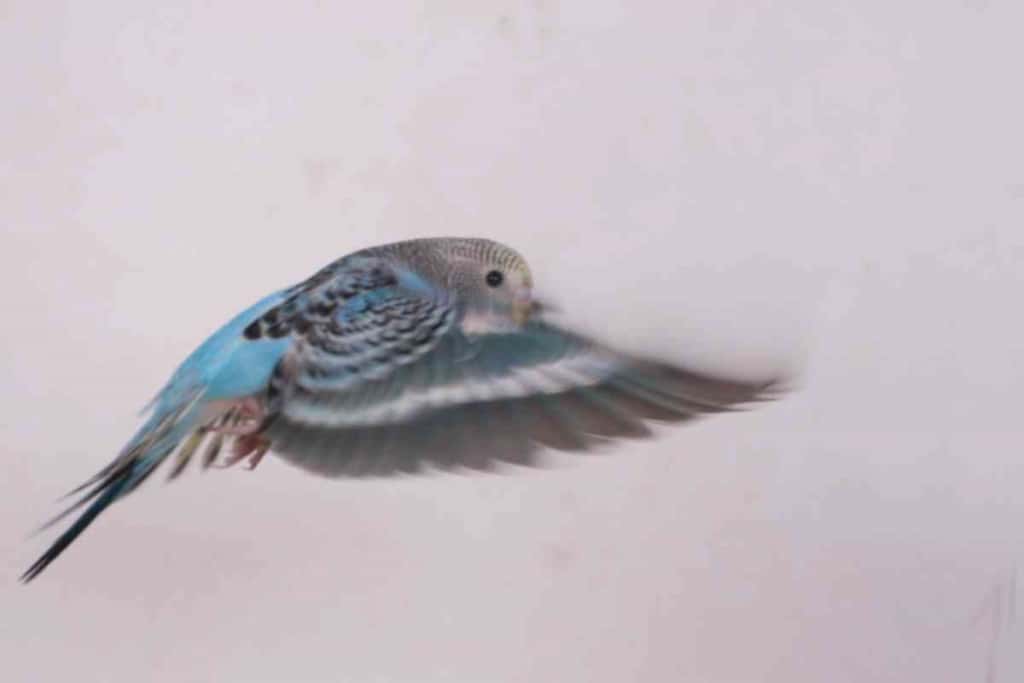Can Budgies Fly Without Tail Feathers?
Budgies are fantastic pets, but their small size and various growth stages can make them fragile. Molting, disease, and rough handling can impact a parakeet’s feather count. Some types of feathers are more critical than others, but can budgies fly without tail feathers? The answer is yes, although it severely inhibits their flight functions. Let’s discuss the role of tail feathers in flight and what it means if your budgie lacks them. Then, we’ll go over what you can do to ensure the safety of your bird while it regrows its tail feathers.

Do Budgies Need Their Tail Feathers to Fly?
Budgies do not need their tail feathers to fly, but they won’t have as much control over their flight. A budgie’s tail feathers act like a rutter to help them steer. Without those tail feathers, your budgie is likely to injure themselves by flying into something they didn’t mean to.
A bird’s feathers fulfill various roles integral to its survival. Soft, downy parts keep your budgie insulated from the cold, and contoured pinions give it an aerodynamic shape in the air. Many feather types contain remiges or places where they fuse with bone, offering a slight degree of protection and firmness.
Just like other types, a budgie’s tail feathers have a function. The long feathers act like the rudder of a ship, letting birds of all kinds steer effectively in the air and gain lift. Most of the lift comes from the feathers on their wings (their flight feathers), so they can still fly without tail feathers. But without them, a bird may struggle to stay level in the air and even fly erratically.
Why Does My Budgie Have No Tail Feathers?
There are many probable reasons why your parakeet might have lost its tail feathers.
First, know that a missing tail feather or two is not necessarily a sign that your budgie is sick or in danger. Molting is a natural process, but birds that molt typically only lose one or two tail feathers at a time to preserve their flight ability.
If your budgie is missing more than that, it could mean more dire causes.
A bird’s tail feathers are more resilient than they appear, but rough handling can make them fall off. Monitor your budgie if it starts crashing into hard surfaces or fighting other birds. When picking up and petting a parakeet, be gentle and only use one finger at a time.
However, too much petting can activate mating hormones, leading to stress and self-plucking.
If your budgie is stressed, it may start plucking its tail feathers off. Many factors, like boredom, hormonal changes, and poor air quality can lead to stress in birds.
Lastly, losing tail feathers is often a sign of disease in birds. French molt is a plague among birds that makes their feather ends brittle and dark-colored, causing them to fall out. Similarly, a bird infected with mites may shed or pluck out its feathers to deter the parasite.
If you suspect a parasite or disease might be affecting your budgie, take it to a trusted avian veterinarian.

What Happens if a Budgie Loses Its Tail Feathers?
What happens if a bird loses its tail feathers? As long as there isn’t an infection or parasite preventing them from regrowing, they will regenerate over time. While that process is underway, birds are vulnerable if they try to fly since having no tail feathers inhibits their mobility.
If not addressed, a lack of tail feathers can cause even more health complications for budgies and other birds.
If a budgie loses its tail feathers, its in-flight handling and maneuvering worsen, making it liable to crash into hard surfaces in its environment and damage itself. Cages, its home walls, the ceiling, and the floor are some examples.
As a result, while parakeets can still fly without all of their feathers, it can still be dangerous to let them attempt it.
Thankfully, budgies typically won’t attempt to fly if their tail feathers are regrowing. Some pet birds are more fond of walking than flying because of their development or personalities. If that sounds like your budgie, it probably won’t be at any risk of flying and crashing.
How Can I Help Keep My Budgie Safe?
There are a few ways to keep your budgie safe while its tail feathers regrow or while it recovers from sickness. Let’s discuss some strategies that will create a safer parakeet environment.
Temporarily Isolate Your Budgie
Keep your budgie away from danger in a cage. If possible, also isolate it from other birds. If you do not know the cause of your budgie’s tail feather loss, it could be that conflicts with your other parakeets could be causing it.
Inside its cage, soften the hard surfaces with birdcage liners. Safe materials like paper or vegetable-tanned leather, and these options also double as a chewing toy for your budgie to keep it occupied.
Limit Time Outside the Cage
Birds are social and curious creatures, and a budgie that always stays in a cage without proper enrichment can become stressed. A stressed bird is much more susceptible to disease and may even pluck its feathers. If it is possible to let your budgie out of the cage, limit its time to minimize the chance of flight accidents.
I recommend selecting and proofing a room for exploration in your home, preferably one with carpet. Try to line any hard surfaces and remove potentially dangerous objects. Finally, supervise your budgie the whole time so you can quickly respond if it attempts to fly and crashes.
Improve the Environment
Parrots and parakeets are sensitive to their environmental conditions, especially air and food quality. Purifying your environment can certainly cause your bird’s condition to improve.
Fume-causing items like paint should be removed from your home and placed outdoors or in a shed. Do not smoke inside the house. Houseplants are an excellent way to help purify the air.
Similarly, give your bird a good balance of dark and light throughout the day, as an imbalance can cause stress.
Enrich and Entertain Your Budgie
Boredom is one of the factors that can cause stress in budgies, resulting in them plucking their feathers. Even if you must isolate your bird, please remember to enrich it by interacting with it and providing activities.
Talking to your bird, playing soft music, petting, and providing chewing materials are great ways to enrich it. As long as they have a non-aggressive relationship, another bird’s presence helps their mental health.
Bathing your bird is also essential, and most budgies love it. Provide a shallow dish for your bird to bathe in, which can rid its skin irritations that may cause self-plucking.
Ask an Avian Veterinarian
A trusted avian veterinarian is your best source of information about what your budgie is going through. They can confirm if your bird is molting or suffering from a disease or parasite. A vet might recommend specific treatments and tips that you can use to keep your environment safe for the budgie.
Conclusion
Can budgies fly without tail feathers? Yes.
It doesn’t necessarily mean imminent danger if your budgie lacks a few tail feathers. But for your beloved pets, it’s critical to take risks seriously. Proof and purify your environment and try to understand what is causing the feather loss. Then you can get your budgie back to a happy state of mind with perfect health.
If you aren’t sure what to do, ask an avian veterinarian for help regarding your budgie’s specific health concerns.
